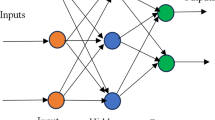Abstract
In this study, the tool wear in gun-drilling process of 37Cr4 forge steel was studied. So, the Taguchi method of design of experiments was used to investigate the effects of inputs (tool tip angles (internal and exterior cutting edge angles, free angle of inner and outer cutting edge) and feed rate) on tool wear as output, experimentally. Also, the feedforward backpropagation neural network was used to predict the tool wear in gun-drilling process considering internal and exterior cutting edge angles, free angle of inner and outer cutting edge and feed rate as input parameters of the neural network. In order to select the best performance network with minimum mean squared error in predicting the tool wear in gun-drilling process, the Taguchi method of design of experiments was used. Once again, the input parameters of this design were the number of neurons in hidden layer, type of training function and transfer function of hidden layer of neural network, and mean squared error obtained from neural network run was the output parameter. According to the results, increasing internal and exterior cutting edge angles leads to higher tool wear, while increasing free angle of inner and outer cutting edge decreases tool wear. The tool wear increases by increasing tool feed rate at the first steps, but it decreases by further increase in feed rate. Also, the mean squared error of the neural network with the best performance to predict the tool wear was 0.000433, the most differences of the network and experimental results were 0.096 µm and the regression R value of the network with the best performance was 0.98468.













Similar content being viewed by others
References
Sihvo I, and Varis J, Mechanika 73 (2008) 1.
Tang J, Jiang Sh, Quan Q, Liang J, Shen Y, Tian Y, and Yuan F, Planet Space Sci 173 (2019) 1.
Baak N, Nickel J, Biermann D, and Walther F, Procedia Struct Integr 18 (2019) 274.
Biermann D, and Kirschner M, J Manuf Process 20 (2015) 332.
Zhang X, Tnay G L, Liu K, and Kumar A S, Int J Mach Tools Manuf 125 (2018) 123.
Tnay G L, Wan S, Woon K S, and Yeo S H, Int J Mach Tools Manuf 108 (2016) 66.
Woon K S, Chaudhari A, Kumar A S, and Rahman M, Procedia CIRP 14 (2014) 593.
Biermann D, Bleicher F, Heisel U, Klocke F, Möhring H C, and Shih A, CIRP Annals 67 (2018) 673.
Woon K S, Kanno Sh, and Liu K, Int J Abrasive Technol 6 (2013) 1.
Basheer I A, and Hajmeer M, J Microbiol Methods 43 (2000) 3.
Mia M, and Dhar N R, J Adv Res 7 (2016) 1035.
Svozil D, Kvasnicka V, and Pospichal J, Chemom Intell Lab Syst 39 (1997) 43.
Tortum A, Yayla N, Celik C, and Gokdag M, Phys A 386 (2007) 446.
Author information
Authors and Affiliations
Corresponding author
Additional information
Publisher's Note
Springer Nature remains neutral with regard to jurisdictional claims in published maps and institutional affiliations.
Rights and permissions
About this article
Cite this article
Rezazadeh, A., Araee, A. & Gholipoor, A. Experimental Investigations and Modeling of Tool Wear in Gun-Drilling Process of 37Cr4 Forge Steel, Using Artificial Neural Network with Taguchi Method. Trans Indian Inst Met 74, 195–203 (2021). https://doi.org/10.1007/s12666-020-02124-2
Received:
Accepted:
Published:
Issue Date:
DOI: https://doi.org/10.1007/s12666-020-02124-2




